Production Management Report: Laminated Timber Frame Benefits Analysis
VerifiedAdded on 2023/01/06
|7
|1887
|27
Report
AI Summary
This report provides a detailed analysis of laminated timber frames (LTF), a modern and innovative structural system, comparing its advantages to traditional pre-cast concrete and structural steel. The introduction defines LTF, highlighting its stability and versatility in various applications. The main body delves into the benefits of LTF, including its high strength and durability, cost-effectiveness, reduced construction time, and positive environmental impact due to its role as a carbon sink and lower waste production compared to concrete and steel. The report also emphasizes the structural effectiveness of LTF, with weight distributed over the entire panel. Furthermore, it discusses the increasing use of LTF in modern buildings, including residential and multi-story constructions, as well as its application in interior design. The conclusion summarizes the key advantages, emphasizing its economic, environmental, and design benefits, making it a superior choice for sustainable and efficient construction. The report is supported by references to books, journals, and online sources.
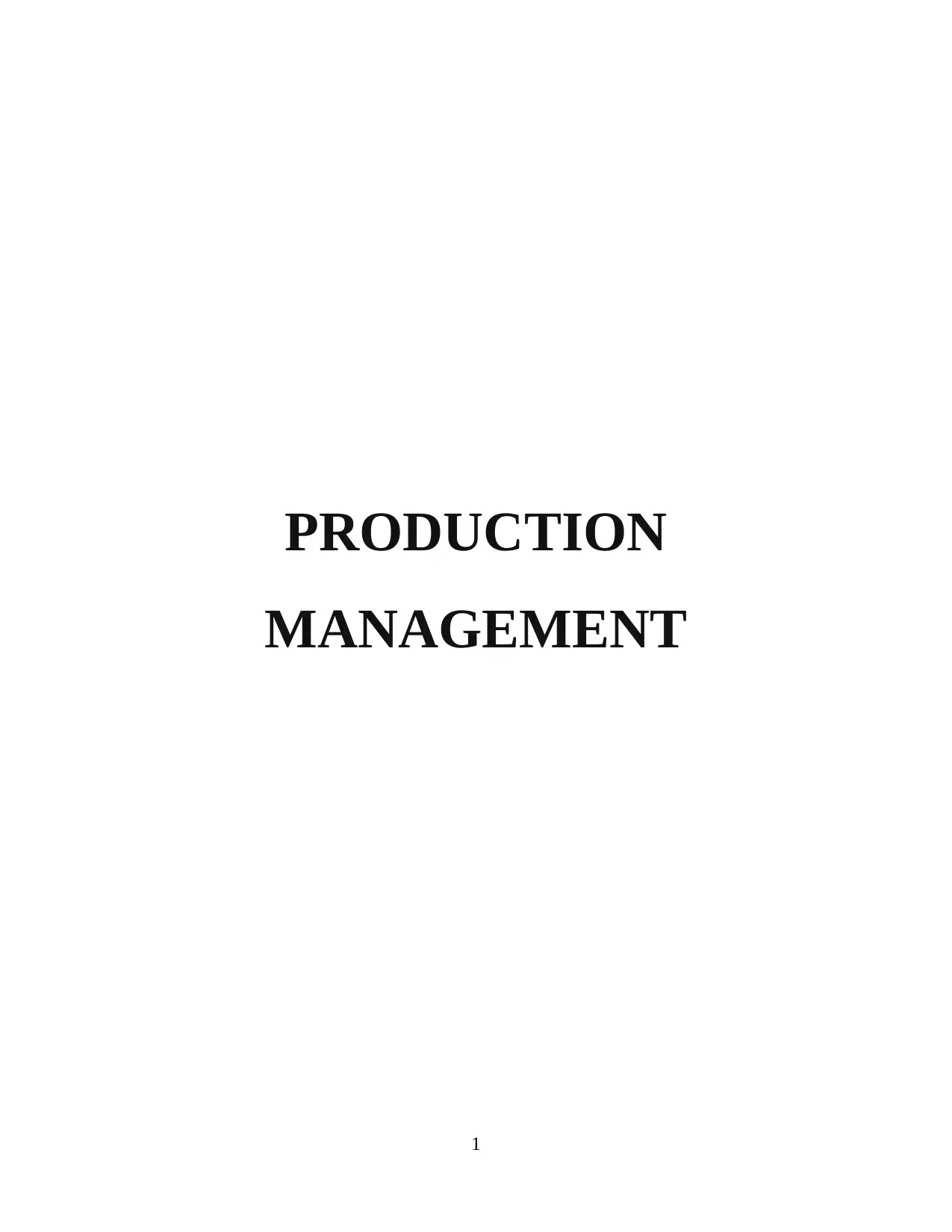
PRODUCTION
MANAGEMENT
1
MANAGEMENT
1
Paraphrase This Document
Need a fresh take? Get an instant paraphrase of this document with our AI Paraphraser
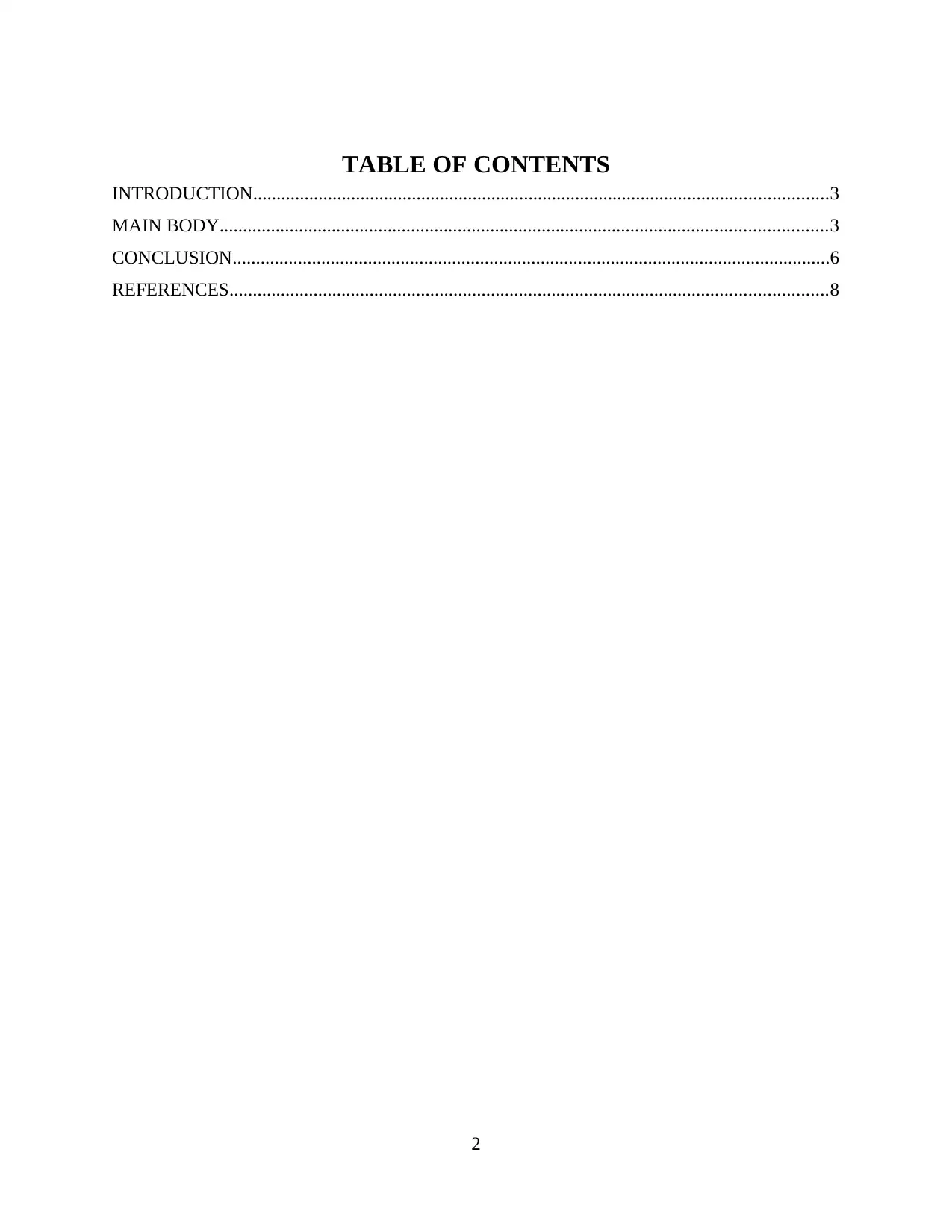
TABLE OF CONTENTS
INTRODUCTION...........................................................................................................................3
MAIN BODY..................................................................................................................................3
CONCLUSION................................................................................................................................6
REFERENCES................................................................................................................................8
2
INTRODUCTION...........................................................................................................................3
MAIN BODY..................................................................................................................................3
CONCLUSION................................................................................................................................6
REFERENCES................................................................................................................................8
2
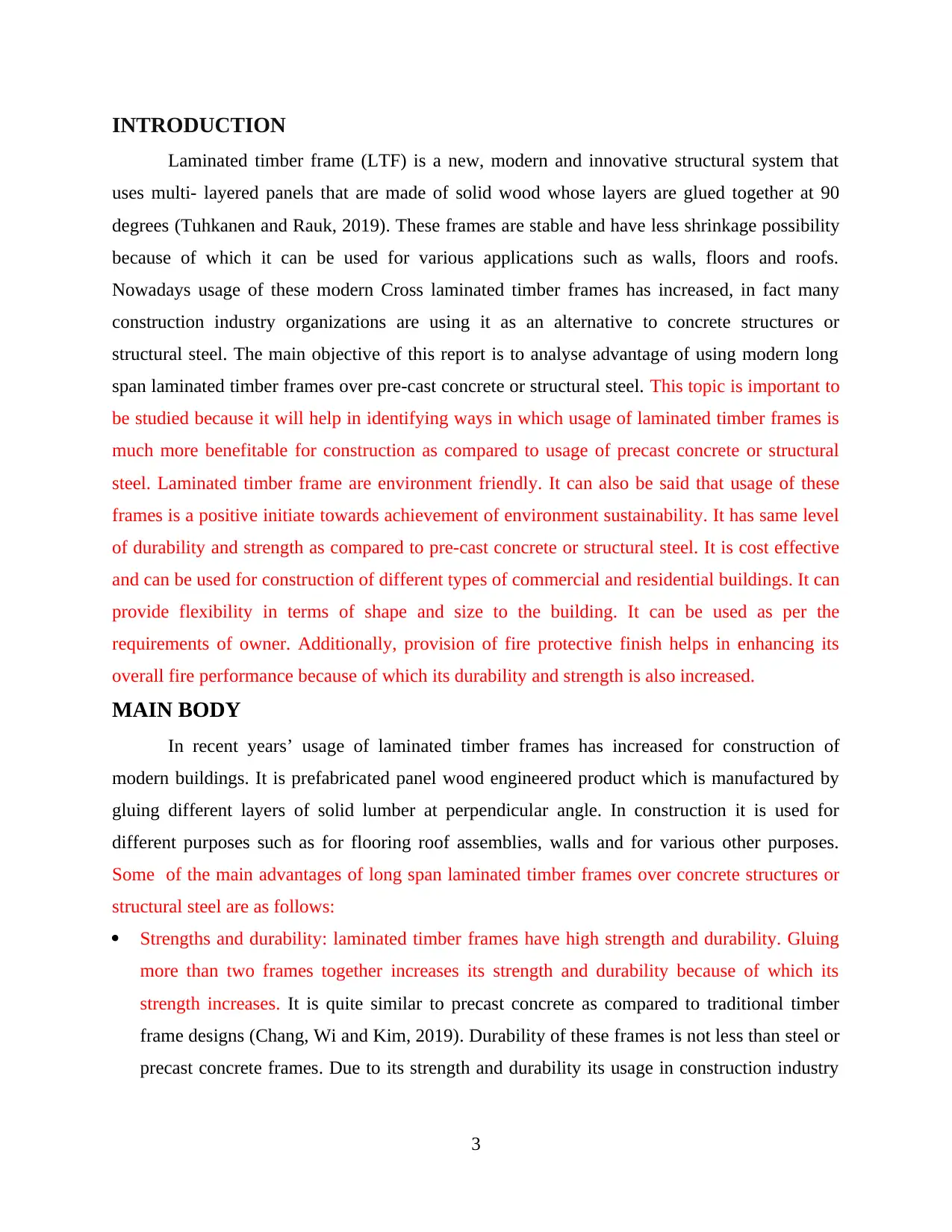
INTRODUCTION
Laminated timber frame (LTF) is a new, modern and innovative structural system that
uses multi- layered panels that are made of solid wood whose layers are glued together at 90
degrees (Tuhkanen and Rauk, 2019). These frames are stable and have less shrinkage possibility
because of which it can be used for various applications such as walls, floors and roofs.
Nowadays usage of these modern Cross laminated timber frames has increased, in fact many
construction industry organizations are using it as an alternative to concrete structures or
structural steel. The main objective of this report is to analyse advantage of using modern long
span laminated timber frames over pre-cast concrete or structural steel. This topic is important to
be studied because it will help in identifying ways in which usage of laminated timber frames is
much more benefitable for construction as compared to usage of precast concrete or structural
steel. Laminated timber frame are environment friendly. It can also be said that usage of these
frames is a positive initiate towards achievement of environment sustainability. It has same level
of durability and strength as compared to pre-cast concrete or structural steel. It is cost effective
and can be used for construction of different types of commercial and residential buildings. It can
provide flexibility in terms of shape and size to the building. It can be used as per the
requirements of owner. Additionally, provision of fire protective finish helps in enhancing its
overall fire performance because of which its durability and strength is also increased.
MAIN BODY
In recent years’ usage of laminated timber frames has increased for construction of
modern buildings. It is prefabricated panel wood engineered product which is manufactured by
gluing different layers of solid lumber at perpendicular angle. In construction it is used for
different purposes such as for flooring roof assemblies, walls and for various other purposes.
Some of the main advantages of long span laminated timber frames over concrete structures or
structural steel are as follows:
Strengths and durability: laminated timber frames have high strength and durability. Gluing
more than two frames together increases its strength and durability because of which its
strength increases. It is quite similar to precast concrete as compared to traditional timber
frame designs (Chang, Wi and Kim, 2019). Durability of these frames is not less than steel or
precast concrete frames. Due to its strength and durability its usage in construction industry
3
Laminated timber frame (LTF) is a new, modern and innovative structural system that
uses multi- layered panels that are made of solid wood whose layers are glued together at 90
degrees (Tuhkanen and Rauk, 2019). These frames are stable and have less shrinkage possibility
because of which it can be used for various applications such as walls, floors and roofs.
Nowadays usage of these modern Cross laminated timber frames has increased, in fact many
construction industry organizations are using it as an alternative to concrete structures or
structural steel. The main objective of this report is to analyse advantage of using modern long
span laminated timber frames over pre-cast concrete or structural steel. This topic is important to
be studied because it will help in identifying ways in which usage of laminated timber frames is
much more benefitable for construction as compared to usage of precast concrete or structural
steel. Laminated timber frame are environment friendly. It can also be said that usage of these
frames is a positive initiate towards achievement of environment sustainability. It has same level
of durability and strength as compared to pre-cast concrete or structural steel. It is cost effective
and can be used for construction of different types of commercial and residential buildings. It can
provide flexibility in terms of shape and size to the building. It can be used as per the
requirements of owner. Additionally, provision of fire protective finish helps in enhancing its
overall fire performance because of which its durability and strength is also increased.
MAIN BODY
In recent years’ usage of laminated timber frames has increased for construction of
modern buildings. It is prefabricated panel wood engineered product which is manufactured by
gluing different layers of solid lumber at perpendicular angle. In construction it is used for
different purposes such as for flooring roof assemblies, walls and for various other purposes.
Some of the main advantages of long span laminated timber frames over concrete structures or
structural steel are as follows:
Strengths and durability: laminated timber frames have high strength and durability. Gluing
more than two frames together increases its strength and durability because of which its
strength increases. It is quite similar to precast concrete as compared to traditional timber
frame designs (Chang, Wi and Kim, 2019). Durability of these frames is not less than steel or
precast concrete frames. Due to its strength and durability its usage in construction industry
3
⊘ This is a preview!⊘
Do you want full access?
Subscribe today to unlock all pages.

Trusted by 1+ million students worldwide
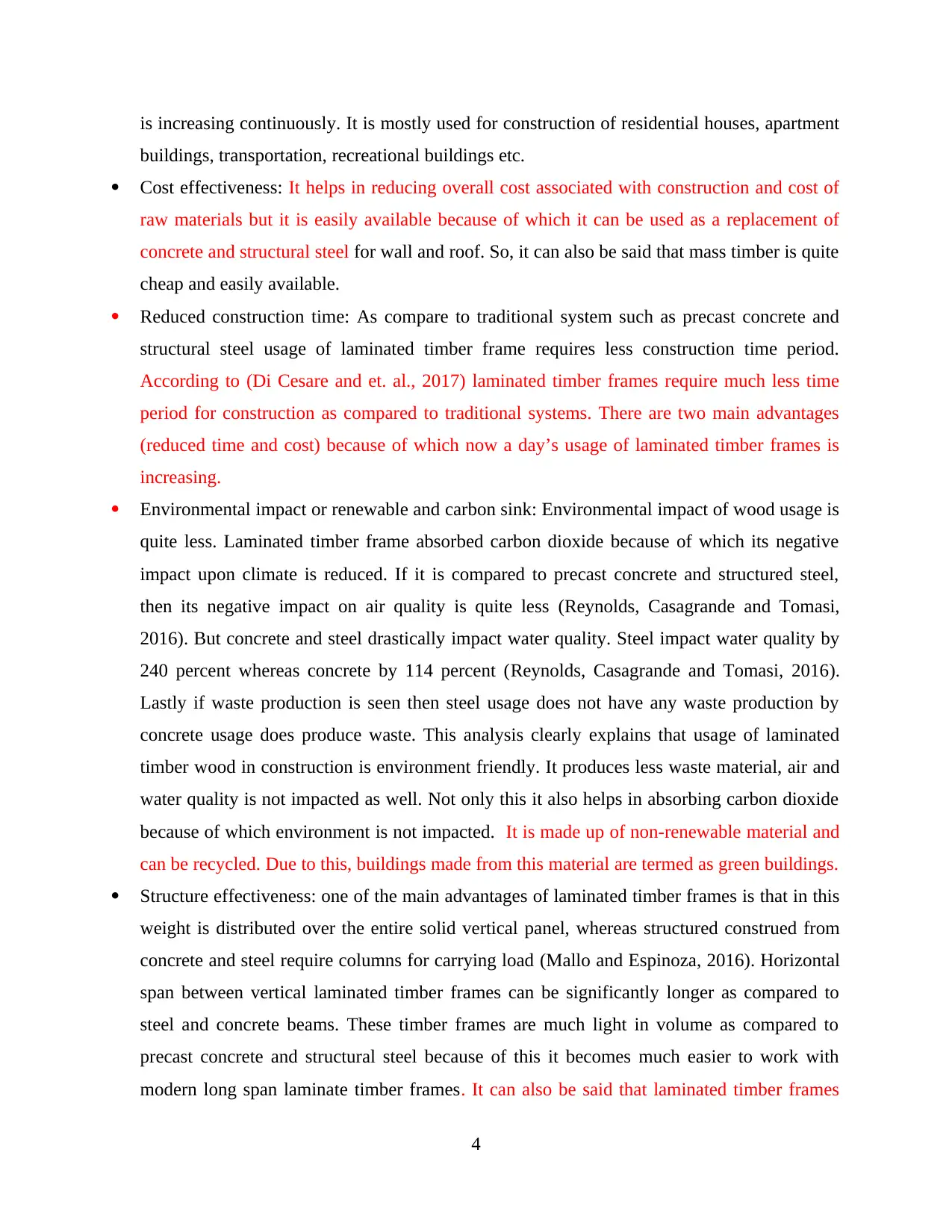
is increasing continuously. It is mostly used for construction of residential houses, apartment
buildings, transportation, recreational buildings etc.
Cost effectiveness: It helps in reducing overall cost associated with construction and cost of
raw materials but it is easily available because of which it can be used as a replacement of
concrete and structural steel for wall and roof. So, it can also be said that mass timber is quite
cheap and easily available.
Reduced construction time: As compare to traditional system such as precast concrete and
structural steel usage of laminated timber frame requires less construction time period.
According to (Di Cesare and et. al., 2017) laminated timber frames require much less time
period for construction as compared to traditional systems. There are two main advantages
(reduced time and cost) because of which now a day’s usage of laminated timber frames is
increasing.
Environmental impact or renewable and carbon sink: Environmental impact of wood usage is
quite less. Laminated timber frame absorbed carbon dioxide because of which its negative
impact upon climate is reduced. If it is compared to precast concrete and structured steel,
then its negative impact on air quality is quite less (Reynolds, Casagrande and Tomasi,
2016). But concrete and steel drastically impact water quality. Steel impact water quality by
240 percent whereas concrete by 114 percent (Reynolds, Casagrande and Tomasi, 2016).
Lastly if waste production is seen then steel usage does not have any waste production by
concrete usage does produce waste. This analysis clearly explains that usage of laminated
timber wood in construction is environment friendly. It produces less waste material, air and
water quality is not impacted as well. Not only this it also helps in absorbing carbon dioxide
because of which environment is not impacted. It is made up of non-renewable material and
can be recycled. Due to this, buildings made from this material are termed as green buildings.
Structure effectiveness: one of the main advantages of laminated timber frames is that in this
weight is distributed over the entire solid vertical panel, whereas structured construed from
concrete and steel require columns for carrying load (Mallo and Espinoza, 2016). Horizontal
span between vertical laminated timber frames can be significantly longer as compared to
steel and concrete beams. These timber frames are much light in volume as compared to
precast concrete and structural steel because of this it becomes much easier to work with
modern long span laminate timber frames. It can also be said that laminated timber frames
4
buildings, transportation, recreational buildings etc.
Cost effectiveness: It helps in reducing overall cost associated with construction and cost of
raw materials but it is easily available because of which it can be used as a replacement of
concrete and structural steel for wall and roof. So, it can also be said that mass timber is quite
cheap and easily available.
Reduced construction time: As compare to traditional system such as precast concrete and
structural steel usage of laminated timber frame requires less construction time period.
According to (Di Cesare and et. al., 2017) laminated timber frames require much less time
period for construction as compared to traditional systems. There are two main advantages
(reduced time and cost) because of which now a day’s usage of laminated timber frames is
increasing.
Environmental impact or renewable and carbon sink: Environmental impact of wood usage is
quite less. Laminated timber frame absorbed carbon dioxide because of which its negative
impact upon climate is reduced. If it is compared to precast concrete and structured steel,
then its negative impact on air quality is quite less (Reynolds, Casagrande and Tomasi,
2016). But concrete and steel drastically impact water quality. Steel impact water quality by
240 percent whereas concrete by 114 percent (Reynolds, Casagrande and Tomasi, 2016).
Lastly if waste production is seen then steel usage does not have any waste production by
concrete usage does produce waste. This analysis clearly explains that usage of laminated
timber wood in construction is environment friendly. It produces less waste material, air and
water quality is not impacted as well. Not only this it also helps in absorbing carbon dioxide
because of which environment is not impacted. It is made up of non-renewable material and
can be recycled. Due to this, buildings made from this material are termed as green buildings.
Structure effectiveness: one of the main advantages of laminated timber frames is that in this
weight is distributed over the entire solid vertical panel, whereas structured construed from
concrete and steel require columns for carrying load (Mallo and Espinoza, 2016). Horizontal
span between vertical laminated timber frames can be significantly longer as compared to
steel and concrete beams. These timber frames are much light in volume as compared to
precast concrete and structural steel because of this it becomes much easier to work with
modern long span laminate timber frames. It can also be said that laminated timber frames
4
Paraphrase This Document
Need a fresh take? Get an instant paraphrase of this document with our AI Paraphraser
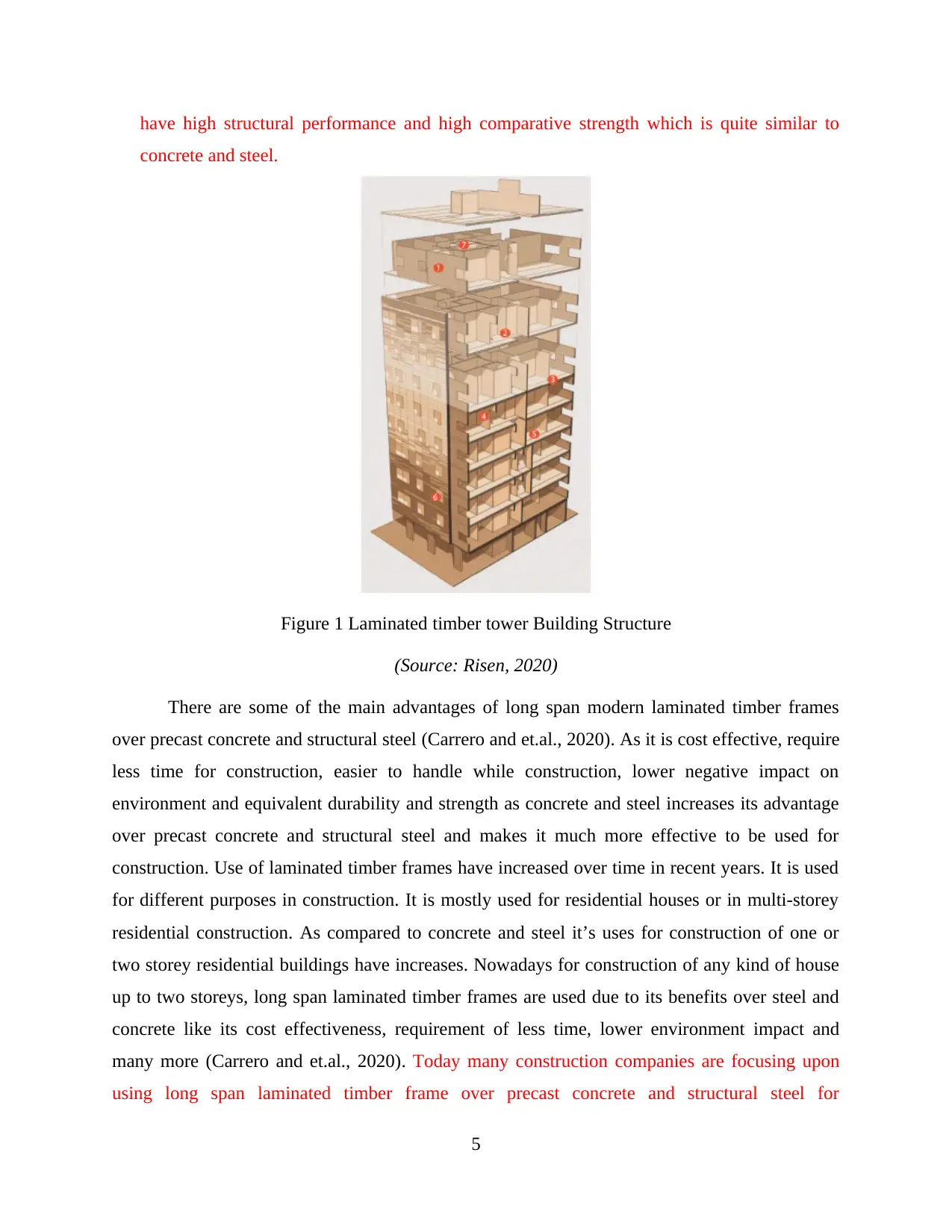
have high structural performance and high comparative strength which is quite similar to
concrete and steel.
Figure 1 Laminated timber tower Building Structure
(Source: Risen, 2020)
There are some of the main advantages of long span modern laminated timber frames
over precast concrete and structural steel (Carrero and et.al., 2020). As it is cost effective, require
less time for construction, easier to handle while construction, lower negative impact on
environment and equivalent durability and strength as concrete and steel increases its advantage
over precast concrete and structural steel and makes it much more effective to be used for
construction. Use of laminated timber frames have increased over time in recent years. It is used
for different purposes in construction. It is mostly used for residential houses or in multi-storey
residential construction. As compared to concrete and steel it’s uses for construction of one or
two storey residential buildings have increases. Nowadays for construction of any kind of house
up to two storeys, long span laminated timber frames are used due to its benefits over steel and
concrete like its cost effectiveness, requirement of less time, lower environment impact and
many more (Carrero and et.al., 2020). Today many construction companies are focusing upon
using long span laminated timber frame over precast concrete and structural steel for
5
concrete and steel.
Figure 1 Laminated timber tower Building Structure
(Source: Risen, 2020)
There are some of the main advantages of long span modern laminated timber frames
over precast concrete and structural steel (Carrero and et.al., 2020). As it is cost effective, require
less time for construction, easier to handle while construction, lower negative impact on
environment and equivalent durability and strength as concrete and steel increases its advantage
over precast concrete and structural steel and makes it much more effective to be used for
construction. Use of laminated timber frames have increased over time in recent years. It is used
for different purposes in construction. It is mostly used for residential houses or in multi-storey
residential construction. As compared to concrete and steel it’s uses for construction of one or
two storey residential buildings have increases. Nowadays for construction of any kind of house
up to two storeys, long span laminated timber frames are used due to its benefits over steel and
concrete like its cost effectiveness, requirement of less time, lower environment impact and
many more (Carrero and et.al., 2020). Today many construction companies are focusing upon
using long span laminated timber frame over precast concrete and structural steel for
5
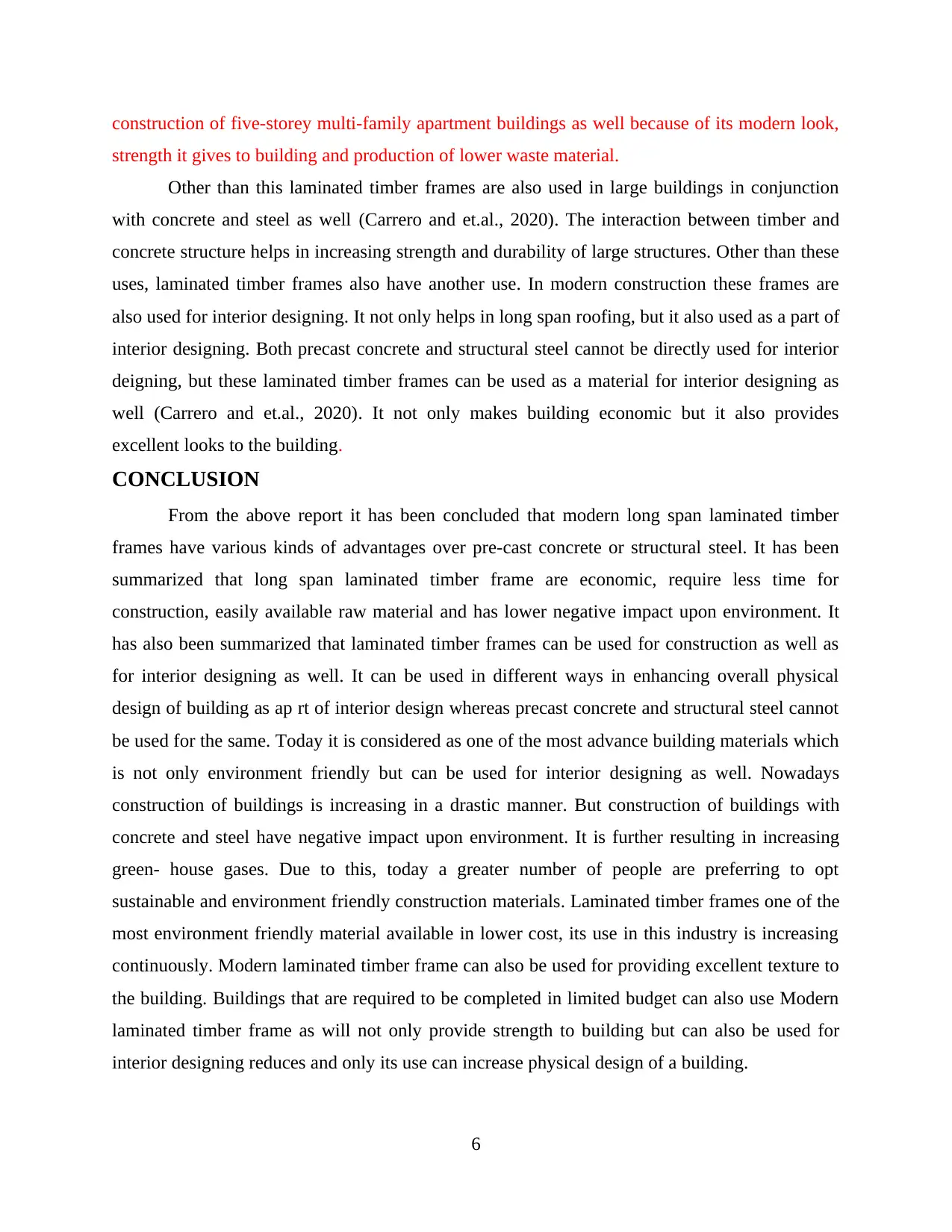
construction of five-storey multi-family apartment buildings as well because of its modern look,
strength it gives to building and production of lower waste material.
Other than this laminated timber frames are also used in large buildings in conjunction
with concrete and steel as well (Carrero and et.al., 2020). The interaction between timber and
concrete structure helps in increasing strength and durability of large structures. Other than these
uses, laminated timber frames also have another use. In modern construction these frames are
also used for interior designing. It not only helps in long span roofing, but it also used as a part of
interior designing. Both precast concrete and structural steel cannot be directly used for interior
deigning, but these laminated timber frames can be used as a material for interior designing as
well (Carrero and et.al., 2020). It not only makes building economic but it also provides
excellent looks to the building.
CONCLUSION
From the above report it has been concluded that modern long span laminated timber
frames have various kinds of advantages over pre-cast concrete or structural steel. It has been
summarized that long span laminated timber frame are economic, require less time for
construction, easily available raw material and has lower negative impact upon environment. It
has also been summarized that laminated timber frames can be used for construction as well as
for interior designing as well. It can be used in different ways in enhancing overall physical
design of building as ap rt of interior design whereas precast concrete and structural steel cannot
be used for the same. Today it is considered as one of the most advance building materials which
is not only environment friendly but can be used for interior designing as well. Nowadays
construction of buildings is increasing in a drastic manner. But construction of buildings with
concrete and steel have negative impact upon environment. It is further resulting in increasing
green- house gases. Due to this, today a greater number of people are preferring to opt
sustainable and environment friendly construction materials. Laminated timber frames one of the
most environment friendly material available in lower cost, its use in this industry is increasing
continuously. Modern laminated timber frame can also be used for providing excellent texture to
the building. Buildings that are required to be completed in limited budget can also use Modern
laminated timber frame as will not only provide strength to building but can also be used for
interior designing reduces and only its use can increase physical design of a building.
6
strength it gives to building and production of lower waste material.
Other than this laminated timber frames are also used in large buildings in conjunction
with concrete and steel as well (Carrero and et.al., 2020). The interaction between timber and
concrete structure helps in increasing strength and durability of large structures. Other than these
uses, laminated timber frames also have another use. In modern construction these frames are
also used for interior designing. It not only helps in long span roofing, but it also used as a part of
interior designing. Both precast concrete and structural steel cannot be directly used for interior
deigning, but these laminated timber frames can be used as a material for interior designing as
well (Carrero and et.al., 2020). It not only makes building economic but it also provides
excellent looks to the building.
CONCLUSION
From the above report it has been concluded that modern long span laminated timber
frames have various kinds of advantages over pre-cast concrete or structural steel. It has been
summarized that long span laminated timber frame are economic, require less time for
construction, easily available raw material and has lower negative impact upon environment. It
has also been summarized that laminated timber frames can be used for construction as well as
for interior designing as well. It can be used in different ways in enhancing overall physical
design of building as ap rt of interior design whereas precast concrete and structural steel cannot
be used for the same. Today it is considered as one of the most advance building materials which
is not only environment friendly but can be used for interior designing as well. Nowadays
construction of buildings is increasing in a drastic manner. But construction of buildings with
concrete and steel have negative impact upon environment. It is further resulting in increasing
green- house gases. Due to this, today a greater number of people are preferring to opt
sustainable and environment friendly construction materials. Laminated timber frames one of the
most environment friendly material available in lower cost, its use in this industry is increasing
continuously. Modern laminated timber frame can also be used for providing excellent texture to
the building. Buildings that are required to be completed in limited budget can also use Modern
laminated timber frame as will not only provide strength to building but can also be used for
interior designing reduces and only its use can increase physical design of a building.
6
⊘ This is a preview!⊘
Do you want full access?
Subscribe today to unlock all pages.

Trusted by 1+ million students worldwide
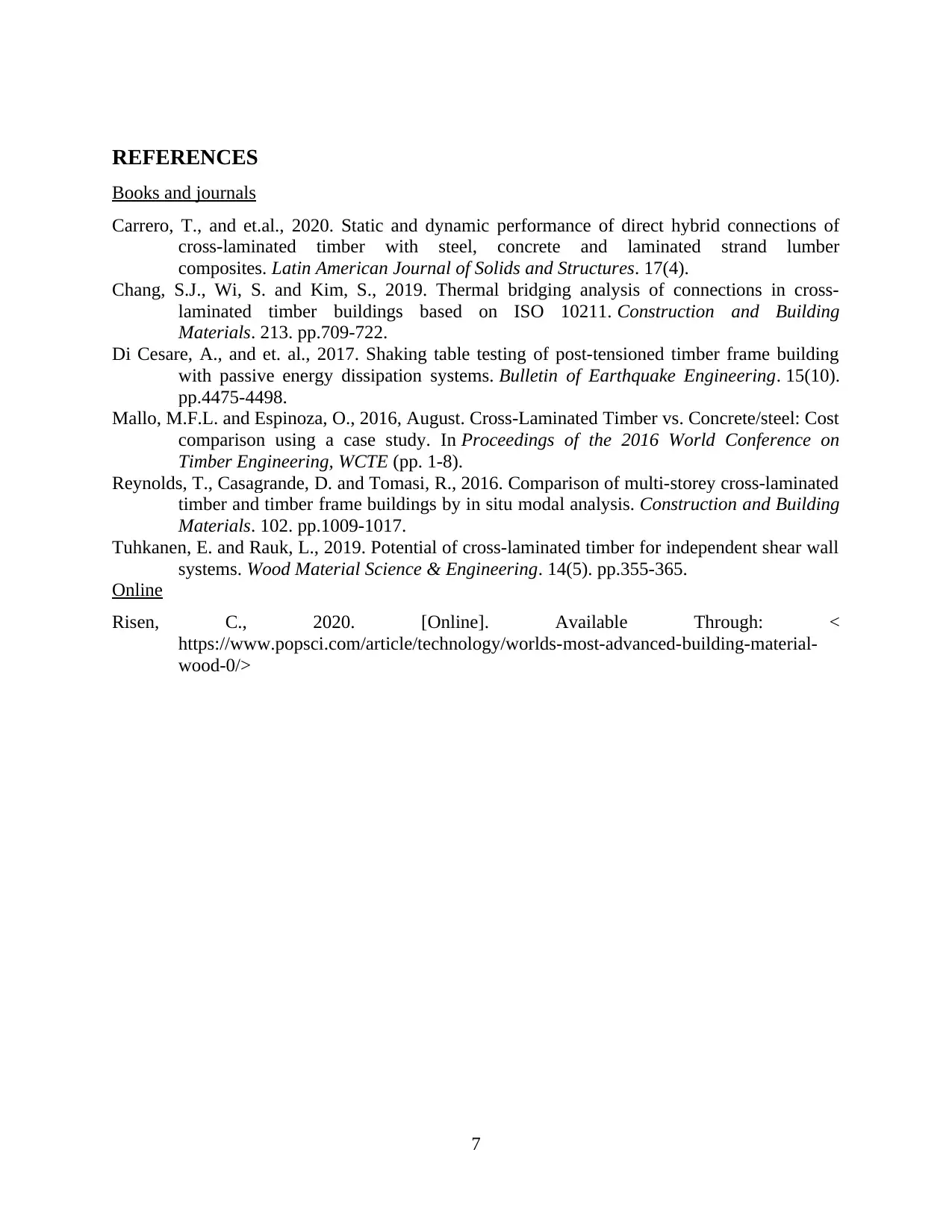
REFERENCES
Books and journals
Carrero, T., and et.al., 2020. Static and dynamic performance of direct hybrid connections of
cross-laminated timber with steel, concrete and laminated strand lumber
composites. Latin American Journal of Solids and Structures. 17(4).
Chang, S.J., Wi, S. and Kim, S., 2019. Thermal bridging analysis of connections in cross-
laminated timber buildings based on ISO 10211. Construction and Building
Materials. 213. pp.709-722.
Di Cesare, A., and et. al., 2017. Shaking table testing of post-tensioned timber frame building
with passive energy dissipation systems. Bulletin of Earthquake Engineering. 15(10).
pp.4475-4498.
Mallo, M.F.L. and Espinoza, O., 2016, August. Cross-Laminated Timber vs. Concrete/steel: Cost
comparison using a case study. In Proceedings of the 2016 World Conference on
Timber Engineering, WCTE (pp. 1-8).
Reynolds, T., Casagrande, D. and Tomasi, R., 2016. Comparison of multi-storey cross-laminated
timber and timber frame buildings by in situ modal analysis. Construction and Building
Materials. 102. pp.1009-1017.
Tuhkanen, E. and Rauk, L., 2019. Potential of cross-laminated timber for independent shear wall
systems. Wood Material Science & Engineering. 14(5). pp.355-365.
Online
Risen, C., 2020. [Online]. Available Through: <
https://www.popsci.com/article/technology/worlds-most-advanced-building-material-
wood-0/>
7
Books and journals
Carrero, T., and et.al., 2020. Static and dynamic performance of direct hybrid connections of
cross-laminated timber with steel, concrete and laminated strand lumber
composites. Latin American Journal of Solids and Structures. 17(4).
Chang, S.J., Wi, S. and Kim, S., 2019. Thermal bridging analysis of connections in cross-
laminated timber buildings based on ISO 10211. Construction and Building
Materials. 213. pp.709-722.
Di Cesare, A., and et. al., 2017. Shaking table testing of post-tensioned timber frame building
with passive energy dissipation systems. Bulletin of Earthquake Engineering. 15(10).
pp.4475-4498.
Mallo, M.F.L. and Espinoza, O., 2016, August. Cross-Laminated Timber vs. Concrete/steel: Cost
comparison using a case study. In Proceedings of the 2016 World Conference on
Timber Engineering, WCTE (pp. 1-8).
Reynolds, T., Casagrande, D. and Tomasi, R., 2016. Comparison of multi-storey cross-laminated
timber and timber frame buildings by in situ modal analysis. Construction and Building
Materials. 102. pp.1009-1017.
Tuhkanen, E. and Rauk, L., 2019. Potential of cross-laminated timber for independent shear wall
systems. Wood Material Science & Engineering. 14(5). pp.355-365.
Online
Risen, C., 2020. [Online]. Available Through: <
https://www.popsci.com/article/technology/worlds-most-advanced-building-material-
wood-0/>
7
1 out of 7
Related Documents
Your All-in-One AI-Powered Toolkit for Academic Success.
+13062052269
info@desklib.com
Available 24*7 on WhatsApp / Email
![[object Object]](/_next/static/media/star-bottom.7253800d.svg)
Unlock your academic potential
Copyright © 2020–2025 A2Z Services. All Rights Reserved. Developed and managed by ZUCOL.





